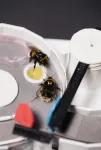(Press-News.org) The team is co-led by Martin Eilers, Chair of Biochemistry and Molecular Biology at the University of Würzburg (JMU). “Our research project is called KOODAC,” he explains. “That stands for ‘Knocking-Out Oncogenic Drivers and Curing Childhood Cancer’”. Our goal is to develop well-tolerated drugs that can target and eliminate cancer cells in children.” The current standard of care for childhood cancer is chemotherapy and radiation therapy, which, even when successful, are associated with severe side effects. “These therapies are often based on drugs that were developed decades ago. In the last 20 years, there has been little progress in curing childhood cancer.”
The research project is funded with up to 25 million U.S. dollars (approximately 23 million euros) by Cancer Grand Challenges, a global funding initiative co-founded by Cancer Research UK and the National Cancer Institute in the U.S. It supports scientific projects worldwide that address the biggest unmet needs in cancer research. The initiative will fund KOODAC’s team of researchers, patient advocates and industry partners for five years. “We have world-class researchers working together on an interdisciplinary basis,” says Eilers. “They are bright minds in structural biology, biochemistry, pediatric oncology and medical chemistry from the U.S., U.K., France, Austria and Germany.” Eilers will co-lead the team with Yaël Mossé, a U.S. physician from Children's Hospital of Philadelphia.
What KOODAC's research is all about
Background: Cancer is caused by mutations in the DNA of cells. These mutations can cause cells to produce proteins that are not normally present in them and drive cancer growth, called oncoproteins. Although currently available drugs can inhibit some of these oncoproteins, many oncoproteins are “undruggable”, meaning they cannot be inhibited by any currently available drug. And almost all oncoproteins that drive cancer growth in children fall into this category. KOODAC aims to solve this problem by using a groundbreaking new technology called “Target Protein Degradation”.
At the heart of this approach is a new generation of drugs known as “degraders”. These can specifically break down oncoproteins via a protein degradation system that is present in all cells. As a result, the mutated cancer cell dies. Unlike chemotherapy or radiation, degraders are not toxic and therefore have fewer side effects. They are also often able to cross the blood-brain barrier. This makes them a potential tool in the fight against brain tumors. Degraders can be given as pills or in liquid form.
Specifically, KOODAC is working to develop drugs against five common childhood cancers: Neuroblastoma, Medulloblastoma, Ewings Sarcoma and Rhabdomyosarcoma as well as a form of Hepatocellular Carcinoma. The team is funded by Cancer Research UK, Institut National Du Cancer and KiKa (Children Cancer Free Foundation) through Cancer Grand Challenges.
About Cancer Grand Challenges
Cancer Grand Challenges was founded in 2020 by two of the world's largest cancer research funders: Cancer Research UK and the National Cancer Institute in the U.S. The initiative supports research teams around the world who are tackling the biggest challenges in the fight against cancer. Grants of up to 25 million U.S. dollars are designed to enable researchers to transcend geographic and disciplinary boundaries. At the beginning of March 2024, the foundation announced its largest funding round to date: In addition to KOODAC, four other research projects were funded for a total of 125 million U.S. dollars (equivalent to more than 115 million euros).
END
25 million US dollars for International Cancer Research
2024-03-06
ELSE PRESS RELEASES FROM THIS DATE:
3D reflector microchips could speed development of 6G wireless
2024-03-06
ITHACA, N.Y. – Cornell University researchers have developed a semiconductor chip that will enable ever-smaller devices to operate at the higher frequencies needed for future 6G communication technology.
The next generation of wireless communication not only requires greater bandwidth at higher frequencies – it also needs a little extra time. The new chip adds a necessary time delay so signals sent across multiple arrays can align at a single point in space-- without disintegrating.
The team’s paper, ...
Adverse childhood experiences and adult mental health outcomes
2024-03-06
About The Study: The results of this study using twin data support an association between adverse childhood experiences and poor mental health in adulthood, notwithstanding evidence for familial confounding from shared genetic and environmental factors. These findings suggest that targeted interventions may be associated with reduced risks of future psychopathology.
Authors: Hilda Björk Daníelsdóttir, M.Sc., of the University of Iceland in Reykjavík, Iceland, is the corresponding author.
To access the embargoed ...
Symptoms of cognitive impairment among children with atopic dermatitis
2024-03-06
About The Study: The findings of this study suggest that pediatric atopic dermatitis (AD) was generally associated with greater odds of reported difficulties in learning and memory. However, this association was primarily limited to children with neurodevelopmental comorbidities, such as attention-deficit/hyperactivity disorder or learning disabilities. These results may improve the risk stratification of children with AD for cognitive impairments and suggest that evaluation for cognitive difficulties should be prioritized among children with AD and neurodevelopmental disorders.
Authors: Joy ...
Charge fractionalisation observed spectroscopically
2024-03-06
A research team led by the Paul Scherrer Institute has spectroscopically observed fractionalisation of electronic charge in an iron-based metallic ferromagnet. Experimental observation of the phenomenon is not only of fundamental importance. Since it appears in an alloy of common metals at accessible temperatures, it holds potential for future exploitation in electronic devices. The discovery is published in the journal Nature.
Basic quantum mechanics tells us that the fundamental unit of charge is unbreakable: the electron charge is quantised. Yet, we have come to understand that exceptions exist. In some situations, ...
Bee-2-Bee influencing: Bees master complex tasks through social interaction
2024-03-06
In a groundbreaking discovery, bumblebees have been shown to possess a previously unseen level of cognitive sophistication. A new study, published in Nature, reveals that these fuzzy pollinators can learn complex, multi-step tasks through social interaction, even if they cannot figure them out on their own. This challenges the long-held belief that such advanced social learning is unique to humans, and even hints at the presence of key elements of cumulative culture in these insects.
Led by Dr Alice Bridges and Professor Lars Chittka , the research team designed a two-step puzzle box requiring ...
New study may broaden the picture of the consequences of childhood adversity
2024-03-06
A research team has examined the link between adverse childhood experiences and the risk of mental health problems later in life, according to a study in JAMA Psychiatry. The researchers from Karolinska Institutet and University of Iceland have found that the risk of suffering from mental illness later in life among those experiencing significant adversity in childhood can be partly explained by factors shared by family members, such as genetics and environment.
Several previous studies have shown that people who have experienced ...
Revealing the evolutionary origin of genomic imprinting
2024-03-06
Some of our genes can be expressed or silenced depending on whether we inherited them from our mother or our father. The mechanism behind this phenomenon, known as genomic imprinting, is determined by DNA modifications during egg and sperm production. The Burga Lab at the Institute of Molecular Biotechnology (IMBA) of the Austrian Academy of Sciences uncovered a novel gene regulation process, associated with the silencing of selfish genes, that could represent the first step in the evolution of imprinting. Their discovery, reported in Nature, ...
Universal tool for tracking cell-to-cell interactions
2024-03-06
One of the fundamental goals of basic biology is understanding how diverse cell types work in concert to form tissues, organs, and organ systems. Recent efforts to catalog the different cell types in every tissue in our bodies are a step in the right direction, but only one piece of the puzzle. The great mystery of how those cells communicate with one another remains unsolved.
Now, a new paper in Nature describes uLIPSTIC, a tool capable of laying the groundwork for a dynamic map tracking the physical interactions between different cells—the elusive cellular interactome. The authors have been perfecting the technology since 2018 and the latest iteration ...
Synthetic DNA sheds light on mysterious difference between living cells at different points in evolution
2024-03-06
“Random DNA” is naturally active in the one-celled fungi yeast, while such DNA is turned off as its natural state in mammalian cells, despite their having a common ancestor a billion years ago and the same basic molecular machinery, a new study finds.
The new finding revolves around the process by which DNA genetic instructions are converted first into a related material called RNA and then into proteins that make up the body’s structures and signals. In yeast, mice, and humans, the first step in a gene’s expression, transcription, proceeds as DNA molecular “letters” (nucleobases) are read in one direction. While 80% of the human genome ...
AI can speed design of health software
2024-03-06
Artificial intelligence helped clinicians to accelerate the design of diabetes prevention software, a new study finds.
Publishing online March 6 in the Journal of Medical Internet Research, the study examined the capabilities of a form of artificial intelligence (AI) called generative AI or GenAI, which predicts likely options for the next word in any sentence based on how billions of people used words in context on the internet. A side effect of this next-word prediction is that the generative AI “chatbots” like chatGPT can generate replies to questions in realistic language, and produce clear summaries of complex texts.
Led ...



